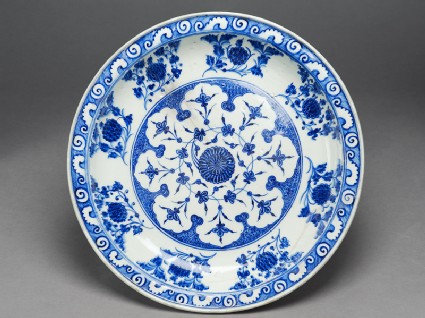Browse: 160 objects
- Reference URL
Actions
Dish with chrysanthemum sprays and lotus flower
-
Details
- Associated place
- Date
-
16th century (1501 - 1600)
Safavid Period (1501 - 1722)
- Material and technique
- fritware, with underglaze painting in blue
- Dimensions
-
8.5 cm (height)
42.7 cm (diameter)
at foot 26.3 cm (diameter)
- Material index
- Technique index
- Object type index
- No. of items
- 1
- Credit line
- Gift of Gerald Reitlinger, 1978.
- Accession no.
- EA1978.1484
-
Further reading
Allan, James W., Islamic Ceramics, Ashmolean-Christie's Handbooks (Oxford: Ashmolean Museum, 1991), no. 31 on p. 52, illus. p. 53
Golombek, Lisa, Robert B. Mason, and Gauvin A. Bailey, Tamerlane's Tableware: A New Approach to Chinoiserie Ceramics of Fifteenth- and Sixteenth-Century Iran, Islamic Art and Architecture, 6 (Costa Mesa, California: Mazda Publishers in Association with Royal Ontario Museum, 1996), pp. 31 (table 3.2), 32, & 154, pls IX (colour) & 67 a & b
Glossary (2)
fritware, underglaze painting
-
fritware
Ceramic material composed of ground quartz and small quantities of clay and finely ground frit (frit is obtained by pouring molten glass into water).
-
underglaze painting
Painting applied to ceramic material before a transparent, or monochrome or coloured glaze for Islamic objects, is applied. The technique was initially developed in China.
Location
-
- currently in research collection
Objects are sometimes moved to a different location. Our object location data is usually updated on a monthly basis. Contact the Jameel Study Centre if you are planning to visit the museum to see a particular object on display, or would like to arrange an appointment to see an object in our reserve collections.
Publications online
-

Islamic Ceramics
Chinese porcelains were held in high esteem in the courts of the fifteenth century Islamic rulers of the Near East. For example, in the second half of the century, documents reveal a steady succession of gifts of Chinese porcelain from the Mamluk Sultans of Egypt and Syria to the Doges of Venice, or to other important European figures. And when the Ottomans captured Cairo in 1517 the thousand camels used to transport the booty to Istanbul must have carried many tens, if not hundreds, of pieces of porcelain, for a contemporary chronicler records porcelains high on the list, fourth only to gold, silver and weapons, in order of importance. Turning to Chinese porcelains at contemporary Persian courts, an Ottoman register records that sixty-four pieces were found in the Hasht Behesht palace and elsewhere in Tabriz, the north-west Persian capital of the Turcoman dynasty, after its capture by Selim I in 1514. And indeed such objects are frequently shown in Persian miniature paintings of the day, either in day to day use, or housed in special rooms to show off to important guests.
The Persian dish illustrated here was probably made in Tabriz early in the sixteenth century, and must have been based on Chinese porcelains seen by the potter in the local bazaar, on their way perhaps to the royal treasury. The Chinese motifs copied by the potter are the rock-and-wave border, the chrysanthemum sprays in the cavetto, and the lotus flower with coiled stem and leaves around it. Chinese potters sometimes used cloud-collars to form a star shape to outline the centre of a dish, but, typically, the Islamic potter has introduced a much stronger geometric flavour to the design through the use of a blue arcade of eight arches, which forces the white, eight-pointed star which it encloses and defines onto the viewer’s attention. The tension between this arcade, the circular stem within it, and the central lotus flower, on the one hand, and the spiral stem breaking into three, on the other, provides the extraordinary drama of the dish.
© 2013 University of Oxford - Ashmolean Museum



